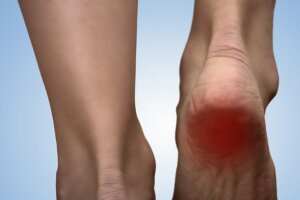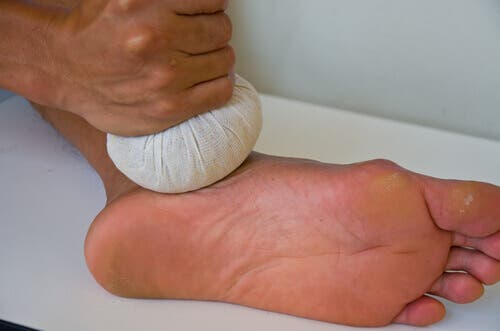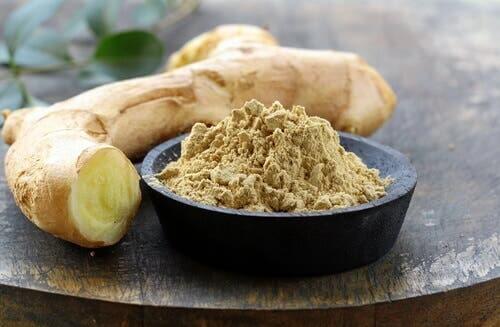5 Remedies for Heel Spur

You can make many different remedies for heel spur with natural ingredients. Although it’s important to follow the therapeutic options recommended by your doctor, these types of supplements can be useful to relieve pain and swelling.
Heel spur is a bone growth that occurs in the lower part of the heel, towards the arch of the foot. It often goes hand in hand with plantar fasciitis, a condition that causes inflammation in the lower part of the foot. Although it’s asymptomatic in some people, it sometimes causes pain that’s difficult to deal with.
5 remedies for heel spur
The remedies for heel spur we share below are natural alternatives that can complement the treatment of this condition. However, it’s important to note that the best way to reduce discomfort is to lower your body weight to ease pressure on the spur.
Likewise, experts recommend the use of comfortable shoes and orthopedic insoles, specifically designed to minimize pain and correct bone calcification. Considering the above, discover the other remedies that you can resort to for this condition.
1. Cold compresses

Applying cold compresses is one of the best-known remedies for heel spur. It’s very beneficial when the condition causes swelling and pain. The cold helps reduce inflammation of the affected heel tissue.
Steps
- For starters, wrap some ice cubes in a cloth and apply them to the spur.
- Leave them on for 10-15 minutes and rest.
- If necessary, repeat the treatment two or three times a day.
- You can also do it after walking a lot or doing physical activity. This way, you avoid the manifestation of pain.
You should also read: Symptoms of Heel Spurs and Treatments
2. Epsom salt bath
Epsom salts (magnesium sulfate) can help fight foot pain, as it has a slight analgesic and anti-inflammatory effect. Using it in baths is quite relaxing and can relieve the discomfort derived from the spur.
Steps
- Add a couple of tablespoons of Epsom salts to a basin of warm water
- Then, soak your feet inside it for 15-20 minutes
- Repeat the treatment every day or whenever you feel pain
3. Remedies for heel spur: ginger poultice

Gingerol, the main active compound in ginger, has anti-inflammatory and analgesic effects that help calm various types of ailments. In this particular case, it’s very beneficial, since it helps relieve plantar fasciitis, derived from the heel spur.
Steps
- Prepare a concentrated ginger infusion by adding a piece of ginger root to hot water
- After about 15 minutes, strain the infusion
- Then, after checking that the temperature is bearable for the skin, soak a gauze pad in the liquid and apply it to the affected heel
- Leave on for 10 minutes and rest
- You can apply it twice a day, every day
4. Essential oil massage
Essential oils are one of the most effective heel spur remedies. Due to their therapeutic capacity, they can minimize heel strain and pain. In addition, since they reactivate circulation, they also contribute to directly fight inflammation.
Steps
- Combine about six drops of arnica essential oil with six drops of chamomile oil and a tablespoon of olive or almond oil.
- Subsequently, gently massage the oils onto the affected area.
- When the products fully absorbed, rest.
- If necessary, repeat their use twice a day.
Read on to learn more: How to Cure a Heel Spur Naturally
5. Avocado liquid extract

Avocado liquid extract is a natural remedy with anti-inflammatory properties. Its external application improves foot circulation and decreases the pressure caused by the heel spur and plantar fasciitis.
Steps
- For starters, grate an avocado seed.
- Then, mix 500 ml of alcohol and two camphor stones in a bottle.
- Let the solution stand for about 20 days, stirring every day.
After this time, soak a gauze pad with the tincture and apply it to the affected area. - Cover it with a bandage and leave on overnight.
- Repeat its application until you feel an improvement.
Is a heel spur afflicting you? If so, choose one of the remedies above and discover their benefits. Remember to consult your trusted doctor if the pain is persistent or severe.
All cited sources were thoroughly reviewed by our team to ensure their quality, reliability, currency, and validity. The bibliography of this article was considered reliable and of academic or scientific accuracy.
- Arankalle D, Wardle J, Nair P. Alternate hot and cold application in the management of heel pain: A pilot study. The Foot. 2016;29:25-28.
- Schwalfenberg G, Genuis S. The Importance of Magnesium in Clinical Healthcare. Scientifica. 2017;2017:1-14.
- Grzanna R, Lindmark L, Frondoza C. Ginger—An Herbal Medicinal Product with Broad Anti-Inflammatory Actions. Journal of Medicinal Food. 2005;8(2):125-132.
- Mashhadi NS, Ghiasvand R, Askari G, Hariri M, Darvishi L, Mofid MR. Anti-oxidative and anti-inflammatory effects of ginger in health and physical activity: review of current evidence. Int J Prev Med. 2013 Apr;4(Suppl 1):S36-42.
- Lakhan S, Sheafer H, Tepper D. The Effectiveness of Aromatherapy in Reducing Pain: A Systematic Review and Meta-Analysis. Pain Research and Treatment. 2016;2016:1-13.
- Dabas D, Shegog R, Ziegler G, Lambert J. Avocado (Persea americana) Seed as a Source of Bioactive Phytochemicals. Current Pharmaceutical Design. 2013;19(34):6133-6140.
This text is provided for informational purposes only and does not replace consultation with a professional. If in doubt, consult your specialist.








